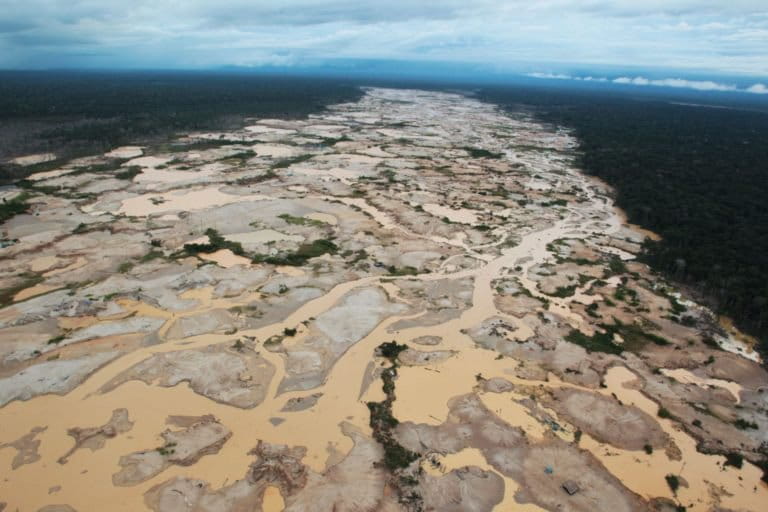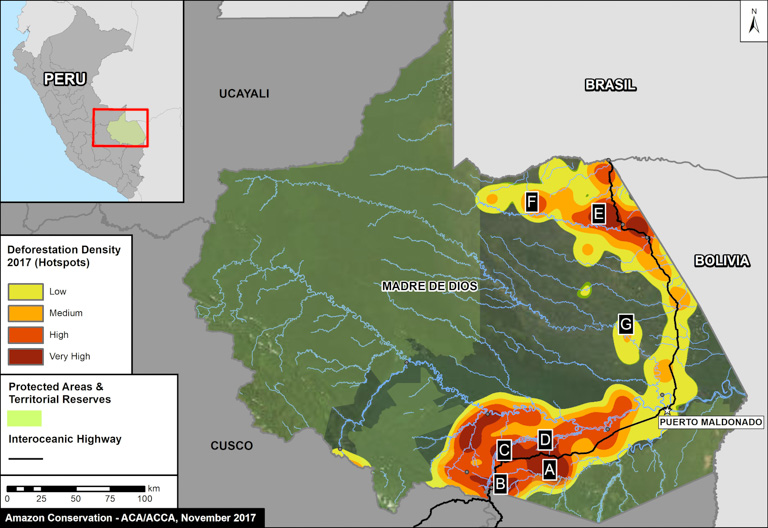- Pope Francis plans to visit Puerto Maldonado in the Peruvian region of Madre de Dios Friday morning on his trip to South America.
- He will speak with indigenous communities in a coliseum.
- Madre de Dios had the second-highest rate of deforestation in the Peruvian Amazon in 2017, with 208 square kilometers (80 square miles) of forest cover loss as a result of farming, logging and mining.
Pope Francis will visit one of the Peruvian Amazon’s most threatened regions today, where the leader of the Catholic Church is expected to address escalating deforestation and uncertainty about indigenous peoples’ rights.
“The Holy Father has a special concern for the Amazon and therefore put as the first point of his journey an encounter with indigenous groups to dialogue, to give a sign of hope,” Salvador Piñeiro, president of the Peruvian Episcopal Conference, said in an article published by Mongabay LatAm. “These topics concern the Pope and he feels them very closely.”

After a visit to Chile earlier this week, the pope is scheduled to fly Friday morning from Lima to Puerto Maldonado, the capital of the Madre de Dios region. It’s a place where logging, agriculture and mining — much of it illegal — have led to the loss of thousands of hectares of rainforest in recent decades. In some cases, these activities have touched off conflicts with local communities.
Buoyed by Pope Francis’s commitment to tackling environmental issues as codified in Laudato Si’, the encyclical he published in 2015 subtitled “On Care for Our Common Home,” campaigners are eager to welcome him to their corner of southeastern Peru. After meeting with local authorities, he will speak to indigenous people in a coliseum.
“It is very symbolic that the pope is going to Madre de Dios, the capital of the country’s biodiversity, home to many indigenous peoples in voluntary isolation, and yet [one that] has seen a growing trend of environmental problems, corruption and poisoning of the ecosystem,” said Pedro Solano, who heads the Peruvian Society for Environmental Law, known as SPDA.

The region of Madre de Dios is in the midst of a “deforestation crisis,” according to the scientists at the NGO MAAP, short for Mapping of the Andean Amazon. Based on their calculations using early-warning alerts from the University of Maryland and Peru’s environment ministry, they’ve tracked an “increasing trend of annual forest loss since 2001, peaking in 2017.”
The 208 square kilometers (80 square miles) of forest loss in 2017 is twice what the region saw in 2008. That means that Madre de Dios has been saddled with the second-highest rate of deforestation in Peru’s slice of the Amazon. To get a better idea of what’s causing this hemorrhage, the MAAP team drilled down into the data covering specific areas.
Gold miners are felling trees in areas around the upper stretches of the Malinowski River, which abuts the wildlife-rich Tambopata National Reserve, as well as the town of La Pampa. Elsewhere, near Santa Rita, Guacamayo and Iberia, small-scale farmers appear to have cut several thousand hectares of forest to plant cacao, corn and papaya.

The satellite imagery has shown the “rapid proliferation of logging roads” around Tahuamanu, according to MAAP. And in 2017, spots of deforestation began to show up in two ecotourism concessions teeming with wildlife near Las Piedras, which locals say are the result of cacao farming and cattle ranching.
“This hotspot is located within a forestry concession, but its impact is troubling due to the extension and density of the new road network,” MAAP reported. The team found evidence of 130 kilometers (81 miles) of new logging roads into forested areas in 2017.
Issues such as logging and mining affect indigenous ways of life, leaders say. The razing of the forest they depend on and the pollution of their waters from mining are among the issues that a coalition led by the group Fenamad, the Native Federation for the Madre de Dios River and its Tributaries, hopes to bring to the forefront with the pope’s visit.
“For us, indigenous peoples, the pope’s arrival is important because it is a leader who is highlighting environmental issues and human rights,” Julio Cusurichi, president of Fenamad, said in another article by Mongabay LatAm.

Also in the group’s proposal are the legal security of their claims to the land and a desire to have a say on large projects such as oil and gas infrastructure, dams for hydropower, and roads that cut through the forests. They also want to see the continued protection of peoples living in voluntary isolation and a recognition of the conservation contributions that indigenous communities make.
Many local and national leaders also see this as an opportunity to elevate the status of indigenous rights and rampant forest destruction on the national agenda.
“Unfortunately, lawmakers have failed to see this reality and are letting an opportunity pass for the organization of the country against this phenomenon and to demonstrate to Peruvians and the pope concrete actions that address this our common house as he calls the world,” said Iris Olivera, program coordinator at the organization Law, Environment and Natural Resources. “We just hope that the pope can raise an agenda, a commitment that we can then follow up on.”
Others envision a mandate arising out of Pope Francis’s choice of where to visit in Peru.
“If the pope comes to Peru and his first trip is to Madre de Dios, he commits us as a country to be able to take effective measures for protecting the environment and combating illegal activities occurring in the region,” said Alicia Abanto, the deputy ombudsman of the Environment, Public Services and Indigenous Peoples.
CITATIONS
Finer M, Novoa S, Garcia R (2017) Pope to visit Madre de Dios (Peru), region with Deforestation Crisis. MAAP: 75.
Hansen, M.C., A. Krylov, A. Tyukavina, P.V. Potapov, S. Turubanova, B. Zutta, S. Ifo, B. Margono, F. Stolle, and R. Moore. 2016. Humid tropical forest disturbance alerts using Landsat data. Environmental Research Letters, 11 (3).
Banner image of Pope Francis by Tânia Rêgo/ABr (Agência Brasil) [CC BY 3.0 br], via Wikimedia Commons.
FEEDBACK: Use this form to send a message to the author of this post. If you want to post a public comment, you can do that at the bottom of the page.
